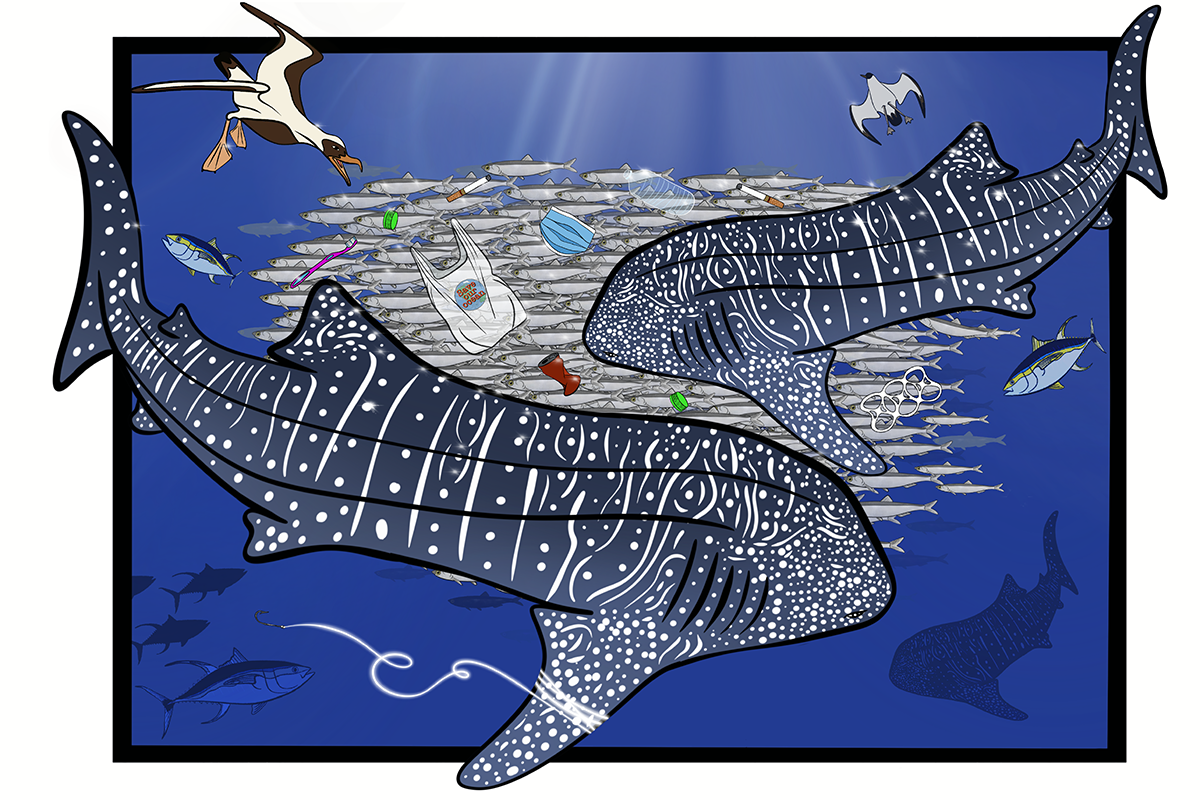Written by: Jess Van Vaerenbergh, USF CMS graduate student
When it comes time to communicate her science to the public, Mya Breitbart often turns to art.
As a microbiologist who studies some of the smallest things on the planet, Breitbart uses art as a creative tool to help others visualize and understand her work.
“Art can offer new perspectives to scientific research and helps make complicated science more accessible to non-scientists,” says Breitbart, a USF Distinguished University Professor at the College of Marine Science. “It’s easy to become narrowly focused as a scientist because you spend so much time thinking about a specific research topic. I find it so inspirational to see the research from an artist’s perspective and love how it broadens my own horizons and makes complex data accessible to a public audience.”
Science is a tool of exploration and discovery that allows us to understand the world around us. Art, in turn, serves as another powerful tool scientists can use to communicate their findings and help others understand their work. From Leonardo da Vinci to modern-day scientists like Guy Harvey, art has been used to provide new perspectives on science.
Using art as a communication tool helps scientists increase public engagement, improve the accessibility of science, and create a space for innovation and creativity within the scientific community.
Motivated by the potential of art to cultivate a deeper appreciation of science, Breitbart, and event organizer Makenzie Kerr created a community engagement event called the Art and Science Exhibit. Most recently held in January 2024 in collaboration with the USF St. Petersburg STEM Club, the event allows CMS researchers and local scientists to showcase a wide variety of art ranging from photography to watercolor. Over three hours, around 80 people browsed the work of CMS scientists (including the author of this article!) sparking diverse conversations and meaningful connections.
"Universities often feel off-limits to the public, robbing them of opportunities to learn about the science being done right in their own community,” Breitbart says. “This event allows us to open our research labs up to the public and collaborate with artists to help share our work with a wider audience. I’m always amazed at the creative projects the artists create and love the feeling of getting a fresh perspective on the science!"
Kerr, who has served as lab manager in Breitbart’s lab since 2018, adds, “Being able to work with artists is such a privilege. The conversations about science spark creative flows that involve much more than our little worlds. Artists can evolve a technique we use in the lab to make something so beautiful and accessible to a larger audience.”
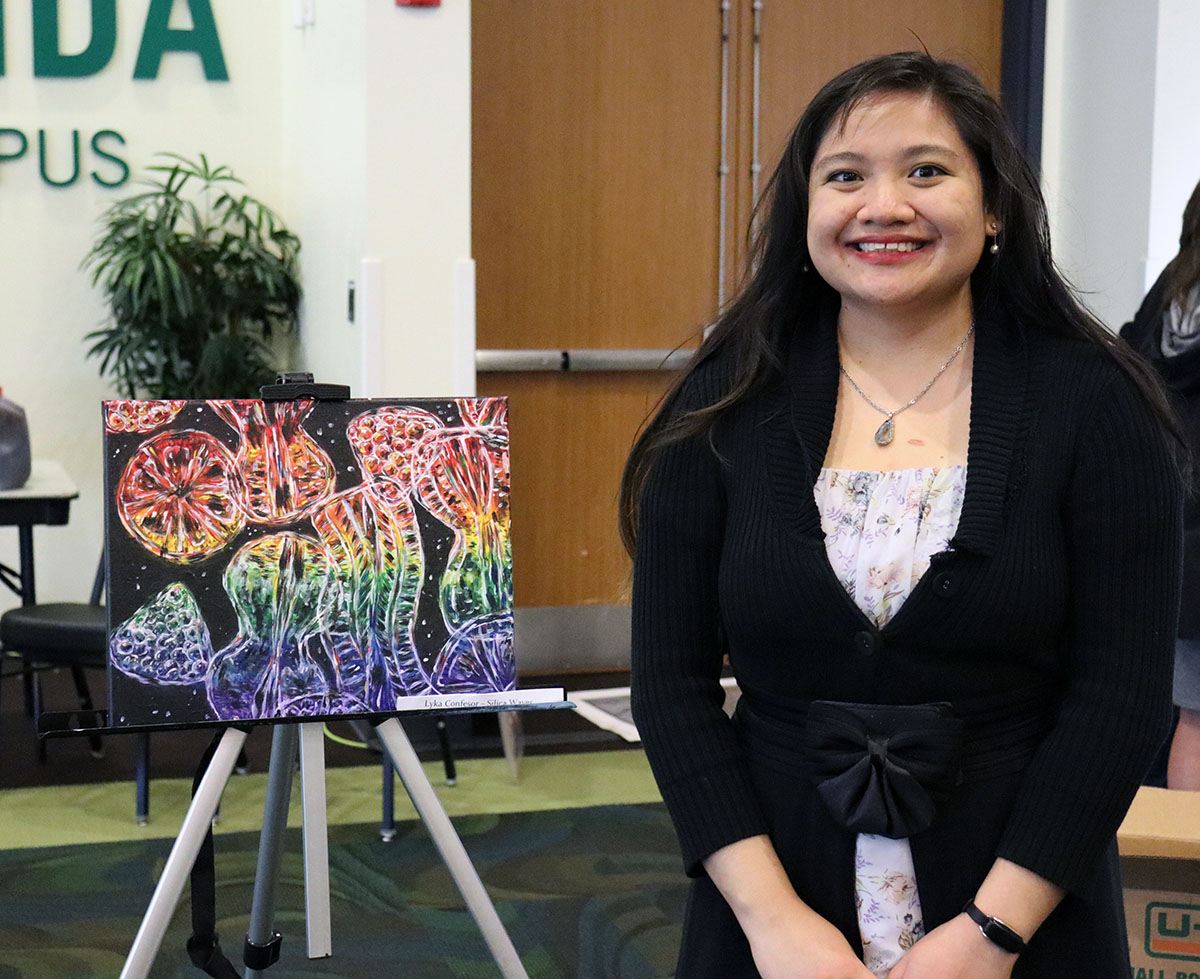
CMS grad student Lyka Confesor showcasing her artwork titled “Silica Waves.” PHOTO CREDIT: Makenzie Kerr.
These types of events allow local community members to learn about research happening in their own backyard. CMS grad student Keith Keel is studying spawning locations of different fish species in the Gulf Coast of Florida and how these locations might change over time. At the Art and Science Exhibit he displayed a photo collage of fish he called “Faces of Tampa Bay.”
Photography can be another effective visual aid that enhances the audience's connection with a scientific concept. For instance, amusing pictures of smiling fish can evoke human emotions in the viewer, making the research more memorable.
One day while fishing, Keel snapped a photo of a sheepshead's mouth, capturing its human-like teeth. He sent the photo to some friends.
"After receiving many exuberant reactions to the picture of the sheepshead, I was inspired to collect and share more portraits of the often-overlooked faces of fish,” Keel says.
Keel is fascinated by fish. In his research and beyond, he is drawn to their intricate, yet often subtle, beauty and the remarkable range of features suited to their unique habitats and lifestyles.
"While my art piece isn't directly related to my research, both my art and my research allow me to explore the captivating diversity of fishes," Keel says. "Showing off my art piece provides the chance to share my passion and hopefully inspire people to see something."
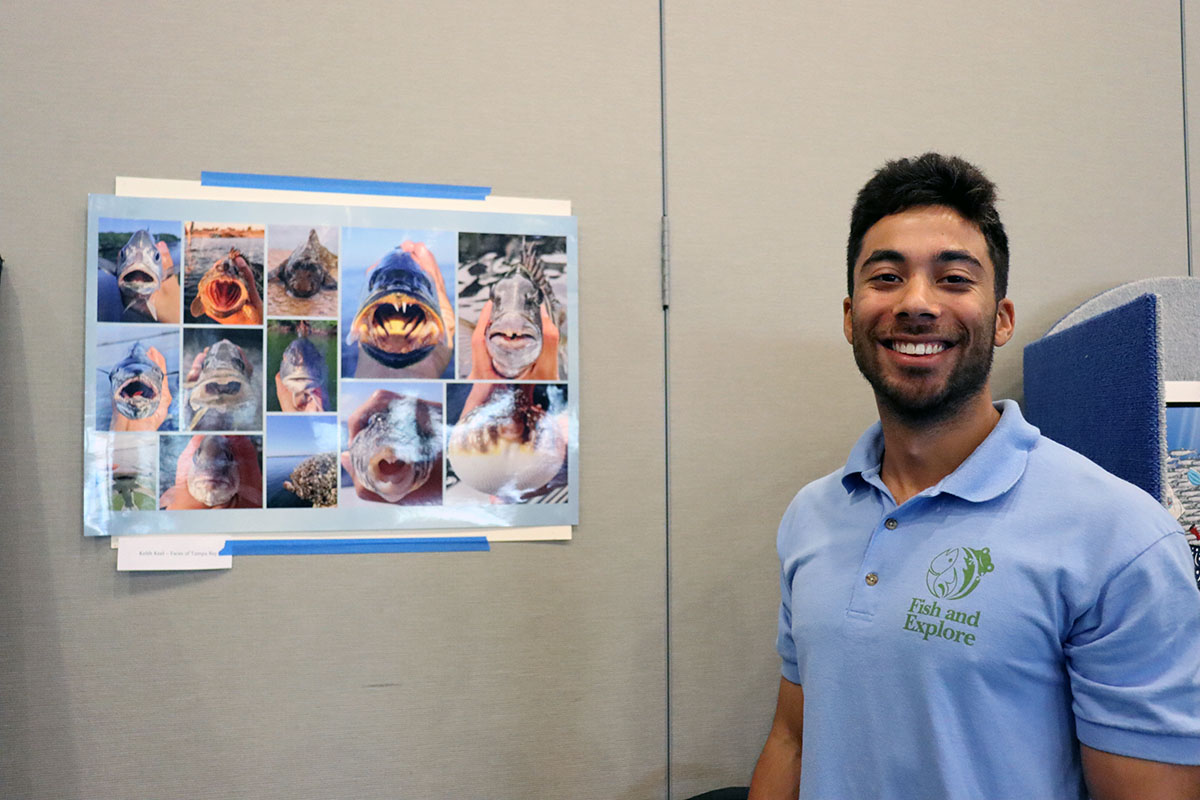
CMS grad student Keith Keel next to his collage of fish titled “Faces of Tampa Bay.” PHOTO CREDIT: Makenzie Kerr.
After long days of reading scientific papers and analyzing data, grad student Sophia Emmons searched for a creative outlet to unwind. She turned to watercolor and painting sharks, and later expanded her portfolio to capture the myriad of colorful marine life. Her artwork draws inspiration from scientific textbooks and field journals that visually represent different species. Emmons believes that accurately depicting an animal is crucial for scientific purposes, which is why she spends so much time on details.
At the Art and Science Exhibit, Emmons displayed a watercolor painting of a rare blue American lobster titled “Cyan.” She selected this lobster due to its connection to her home state of Maine, and the vivid blue coloration of the lobster was perfect for watercolors. Emmons also found it fascinating that a color variation within a species can result in a blue-colored critter.
Emmons participated in the Art and Science Exhibit not only to showcase her work but also to gain inspiration from other artists and build stronger connections within the community.
"Science can be all-consuming sometimes, especially between colleagues, but witnessing the art created by my peers is a wonderful reminder that we are all here celebrating the ocean and the planet through our own creativity," she says.
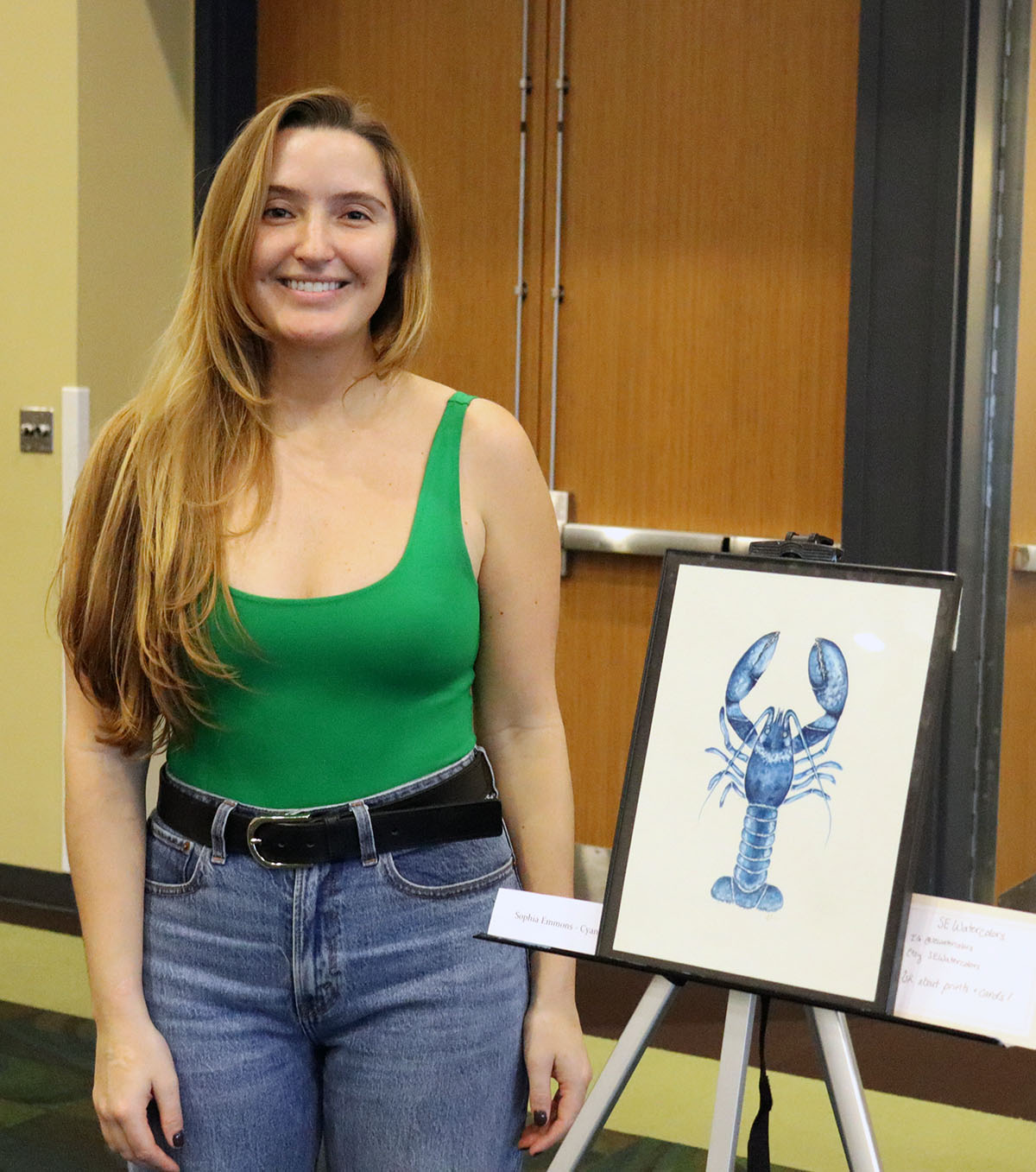
CMS grad student Sophia Emmons next to her watercolor painting titled “Cyan.” PHOTO CREDIT: Makenzie Kerr.
A performing-arts project titled "Findings" was presented at the Art and Science Exhibit by the local arts group Sparks Collaborative Ensemble. The performer, Mimi Rice, dawned an urchin hat and took the audience through a journey of scientific discovery, highlighting Breitbart and her team’s crucial work on the deadly epidemic killing long-spined sea urchins.
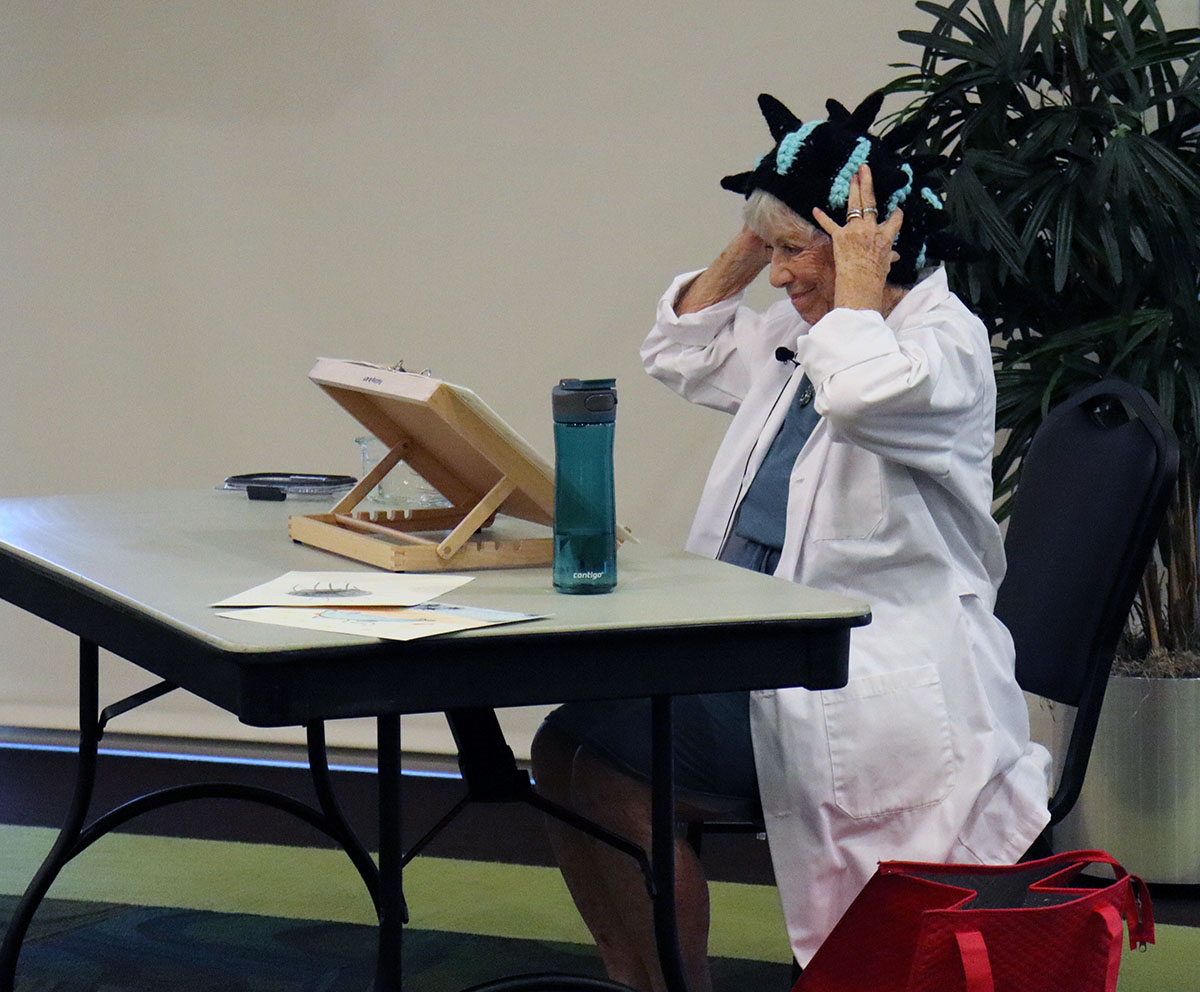
Mimi Rice wearing the infamous urchin hat while preforming the “Findings.” PHOTO CREDIT: Makenzie Kerr.
To expand the story's reach, the recordings from the performance were curated into a YouTube video and later adapted into an illustrated audiobook.
Using creative platforms such as YouTube, research can be shared engaging and accessible ways, allowing a broader audience to connect with science. The story not only captivated the audience at the live performance but now continues to engage an audience broader than the local community.
VIDEO ABOVE: Live performance at the Art and Science Exhibit of Mimi Rice Preforming “Findings.”
Formats like illustrated audiobooks enhance accessibility and engagement for audiences who prefer audio formats or enjoy visual elements. Both videos add depth to the storytelling and provide a richer experience for the audience.
VIDEO ABOVE: Illustrated audiobook of Mimi Rice Preforming “Findings.”
Breitbart and Kerr plan to hold the Art and Science Exhibit annually, featuring different topics to inspire artists at each new exhibit. They hope to expand their network and introduce more community members to the intricacies of our ocean.
"I thought this event was a huge success! One thing that I didn’t expect was how many artistically talented scientists there are at CMS," says Breitbart. "I love that we had several pieces from professional artists as well as professional scientists."
She even challenged herself by creating a “Playing with Plankton” exhibit where she repurposed toys from her childhood (Viewmasters, Kaleidoscopes, Lite-Brite, Origami) to showcase the tiny creatures that dominate our oceans.
Read more: An interdisciplinary team of faculty and students turn environmental impact data into music
